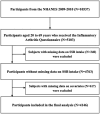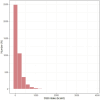Sugar-sweetened beverage intake and chronic low back pain
- PMID: 39021606
- PMCID: PMC11252024
- DOI: 10.3389/fnut.2024.1418393
Sugar-sweetened beverage intake and chronic low back pain
Abstract
Background: The consumption of sugar-sweetened beverages (SSBs) has become a major public health problem globally. However, no studies have specifically examined the relationship between SSB intake and chronic low back pain (CLBP). Therefore, the present study aimed to investigate the relationship between SSB intake and the risk of CLBP.
Methods: This cross-sectional study enrolled participants aged 20 to 69 from the National Health and Nutrition Examination Survey. CLBP was defined as persistent LBP for a consecutive three-month period. Furthermore, SSB intake was assessed and calculated based on dietary recall interviews. Moreover, survey-weighted logistic regression models were employed to evaluate the association between SSB intake and the risk of CLBP, while the restricted cubic spline (RCS) analysis was used to determine whether there were nonlinear associations between SSB intake and CLBP risk. In addition, subgroup analysis was performed using stratification and interaction analysis for all covariates.
Results: A total of 4,146 participants (mean age: 43.405 years) were enrolled in the final analysis. The results of survey-weighted logistic regression models showed that SSB consumption was significantly associated with an increased risk of CLBP among individuals aged 20 to 69 years. Moreover, the results of subgroup analysis and interaction analysis demonstrated that the association between SSB intake and the risk of CLBP was modified by smoking status and hypertension. Specifically, the SSB intake-associated CLBP risk was more pronounced among current smokers or individuals with hypertension.
Conclusion: Reduction of SSB consumption might contribute to the prevention of CLBP for individuals aged 20 to 69 years. Moreover, current smokers or individuals with hypertension should be more vigilant about the SSB intake-associated CLBP risk. Nevertheless, caution should be exercised when interpreting the results of this study, as further research is necessary to explore the association between SSB consumption and CLBP, given the limitations of the current study.
Keywords: NHANES; chronic low back pain; hypertension; smoking; sugar-sweetened beverage.
Copyright © 2024 Wang, Tang, Li, Jiang, Jiang and Hu.
Conflict of interest statement
The authors declare that the research was conducted in the absence of any commercial or financial relationships that could be construed as a potential conflict of interest.
Figures




Similar articles
-
The associations between the energy and timing of sugar-sweetened beverage intake and phenotypic age acceleration in U.S. adults: a cross-sectional survey of NHANES 2007-2010.BMC Public Health. 2025 Jan 8;25(1):88. doi: 10.1186/s12889-024-21249-3. BMC Public Health. 2025. PMID: 39780125 Free PMC article.
-
Both absolute and relative sugar-sweetened beverage intake are associated with kidney stones in U.S. middle-aged and young adults.World J Urol. 2025 Apr 23;43(1):244. doi: 10.1007/s00345-025-05643-z. World J Urol. 2025. PMID: 40266421
-
Examining changes in school vending machine beverage availability and sugar-sweetened beverage intake among Canadian adolescents participating in the COMPASS study: a longitudinal assessment of provincial school nutrition policy compliance and effectiveness.Int J Behav Nutr Phys Act. 2018 Nov 27;15(1):121. doi: 10.1186/s12966-018-0754-5. Int J Behav Nutr Phys Act. 2018. PMID: 30482211 Free PMC article.
-
Changes in prices, sales, consumer spending, and beverage consumption one year after a tax on sugar-sweetened beverages in Berkeley, California, US: A before-and-after study.PLoS Med. 2017 Apr 18;14(4):e1002283. doi: 10.1371/journal.pmed.1002283. eCollection 2017 Apr. PLoS Med. 2017. PMID: 28419108 Free PMC article.
-
Association Between Sugar-Sweetened Beverage Consumption and Frailty Among Older Adults With Hypertension: Evidence From the National Health and Nutrition Examination Survey 1999-2020.Food Sci Nutr. 2024 Dec 30;13(1):e4679. doi: 10.1002/fsn3.4679. eCollection 2025 Jan. Food Sci Nutr. 2024. PMID: 39803219 Free PMC article.
References
-
- Global, Regional, and National Incidence . Prevalence, and years lived with disability for 354 diseases and injuries for 195 countries and territories, 1990-2017: a systematic analysis for the global burden of disease study 2017. Lancet. (2018) 392:1789–858. doi: 10.1016/s0140-6736(18)32279-7 - DOI - PMC - PubMed
LinkOut - more resources
Full Text Sources
Miscellaneous

